Fertilizer For A Persimmon Tree
Persimmon trees grow natively in the Southeastern United States, but many delicious cultivars originated in Asia. The natives are either 'Diospyros virginiana' or 'Diospyros texana', though the latter isn't known for producing tasty fruit. 'Diospyros kaki' is the oriental variety, and grows best in Southern and coastal states where frosts won't harm them. All of these trees are relatively low maintenance, and the American variety is even hardy to 20 degrees below zero.
Don't Over-Fertilize
Persimmons don't need much by way of fertilizer. Fertilizer that leeches from nearby lawn is usually more than enough for adequate growth of the tree. Applying excess nitrogen during fruiting causes fruit drop. Excessive nitrogen can also force vegetative growth at the expense of fruits. If the planting area has already been amended with organic matter, little to no fertilization of any kind should be necessary.
- Persimmon trees grow natively in the Southeastern United States, but many delicious cultivars originated in Asia.
- Diospyros kaki' is the oriental variety, and grows best in Southern and coastal states where frosts won't harm them.
Time Frame
If the branches have put on less than a foot of growth the preceding year, consider fertilizing in the spring, just as new shoots are emerging. Avoid fertilizing in summer, as it will stress the tree. Don't fertilize or add composts after blooming under any circumstances, or you may lose your fruits. Fertilizing during the winter will likely be wasted, especially if you're growing hardy persimmons in Northern states and the ground is hard-frozen.
Organic Fertilizing
Organic fertilizers such as fish emulsion, kelp and seaweed extracts, alfalfa meal and manures can be added in early spring. Compost may be added anytime from early spring to midsummer as mulch. Compost provides longer-lasting results for overall soil structure and plant quality. It has the added benefit of moderate amounts of nitrogen, avoiding the problem of excessive vegetative growth.
- If the branches have put on less than a foot of growth the preceding year, consider fertilizing in the spring, just as new shoots are emerging.
Chemical Fertilizing
Oriental varieties of persimmons grown in Hawaii are treated with 16-16-16 or 10-20-20 N-P-K fertilizers to ensure production, according to the University of Hawaii – Manoa. The first number in these is nitrogen, and it's important to note that the stronger fertilizer still has low nitrogen. California Rare Fruit Growers recommends fertilizing with a 10-10-10 fertilizer only if the previous year's shoot growth was less than a foot.
Considerations
The low fertilization requirement and relative ease of growing persimmons (especially native persimmons)make them ideal for organic and permaculture gardens. Native persimmons also grow well in partial shade, though fruiting will be marginally less. You can grow them near leguminous trees such as mesquites or locust trees. Trim these trees heavily in mid-spring, and they will shed their nitrogen-fixing roots. The nitrogen will permeate the soil, and fertilize the intermingled roots of the persimmon tree.
- Oriental varieties of persimmons grown in Hawaii are treated with 16-16-16 or 10-20-20 N-P-K fertilizers to ensure production, according to the University of Hawaii – Manoa.
- The low fertilization requirement and relative ease of growing persimmons (especially native persimmons)make them ideal for organic and permaculture gardens.
